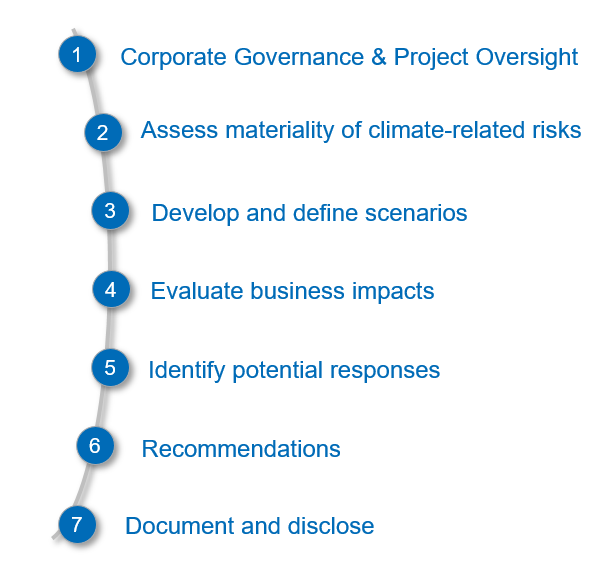What was the initial approach used?
The approach we used combined off-the-shelf climate scenarios with our own existing internal scenarios and narratives.
In mid-2019, we conducted an internal scenario planning project to help inform our future Ricardo plc strategy. As part of this project, we created four scenarios, each describing the world around Ricardo in 2035. We built scenarios using interviews with multiple stakeholders across the business and employed a standard process which varied according to the ‘Axis of Uncertainty’ i.e. the degree of unknowns in the future world.
The four Ricardo 2035 Scenarios – ‘Creative Scavengers,’ ‘Technopolis,’ ‘Digitopolis,’ and ‘Ecopolis’ – already contained some climate-related risks and opportunities, and indeed other potential future challenges (…including pandemics, water, and cyberterrorism).
However, in order to fully integrate the scenarios within our TCFD pilot, we expanded the climate-related content using the following process:
- Our internal Environmental consultants overlaid our existing narratives with external climate scenarios, including the World Energy Outlook Scenarios, PRI’s Inevitable Policy Response scenario, to define temperature trajectories.
- We reviewed an IPCC impact assessment (“Managing the risks and extreme events and disasters to advance climate change adaption”) to develop new features for our scenario narratives, consistent with both scenario ethos, and temperature trajectory.
What were the barriers, and how were they overcome?
The major barrier for our Ricardo plc pilot was ensuring alignment between different studies: Our existing scenarios, climate scenarios, and impact assessments. While there is significant correlation between the two, gaps did exist. For instance, our scenarios are based in 2035, whereas climate scenarios can involved projections up to 2100. So, we had to be careful to write timeline-appropriate narratives–essentially, events that could happen before 2050. Other examples included integrating events that reflected acute physical risks, such as extreme weather events (acute physical risks). To reflect chronic physical risks, we included narratives based on areas of the world most vulnerable to sea-level rise.
By being pragmatic, and accepting that this exercise was not going to be perfect first time out, we were able to develop engaging scenarios – words, numbers, and pictures. Getting buy-in for this approach was not easy. The power of scenario narratives is difficult to explain to the uninitiated. However, after pressing ahead, we found that our scenarios helped engage stakeholders across our business with the TCFD process.
Further insights
From my 15 years experience in futures research, it is very clear that many organisations are uncomfortable with ‘the future’. They are set up to respond to linear forecasts and projections; organisations prefer predictability, data, evidence, and clear correlations. Unfortunately, the future doesn’t work like that. There is no data, and you cannot reliably predict the future. Events (‘black swans’) can knock a hitherto accurate forecast off track.
Scenarios are powerful because they are not predictions. They describe possible futures, and reflect critical uncertainties.
So we believe TCFD could precipitate a shift in thinking. Scenarios built for TCFD applications are very powerful because they can reflect the certain (e.g. inevitable physical shifts) and the uncertain (e.g. political response to climate change). They also promote reflection, systems thinking and a consideration of consequences. For instance, our future scenarios not only talk feature events that directly relate to climate risks and opportunities, but also cover adjacent issues such as transportation shifts, water shortages, and pandemics. No issue exists in isolation.
